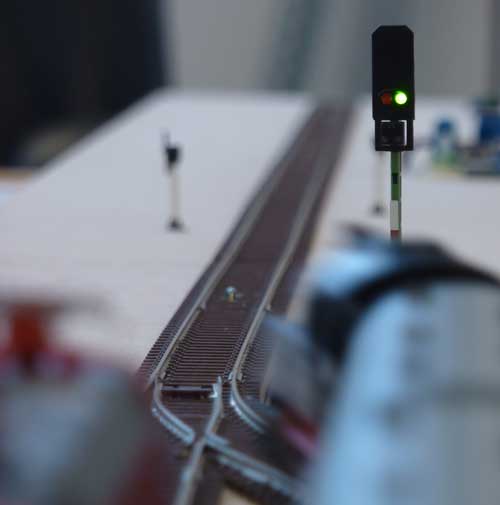Commuter Train Automatics for Two Trains
[an error occurred while processing this directive]Presented at the exhibition modell hobby spiel in Leipzig, Oct. 2013
Two locomotives wait in separate sidings. After activation they go back and forth a line one after another.
| Order number: ABLST_TRAIN_0010 |
Available: [an error occurred while processing this directive]currently not available |
Control: analogue ✓, digital ✓, i.e. push buttons or DCC |
Available as:
[an error occurred while processing this directive]U8, Commuter Train Automatics for Two Trains
Decoder U8 with sequence Commuter Train Automatics for Two Trains
- Product Contents: U8, with sequence, configured & tested
- Order number: U8+ABLST_TRAIN_0010 Price: 104.00 €

Description
The points are set and the exit signal of the two-track station area switches to Green. The first loco passes the points and enters the one-track section through the level crossing. It stops at the end of the track and waits. After some seconds the loco returns to its place.
The points are set for the second train. The exit signal switches to Green again. The seconde train passes the points through the level crossing and waits at the end of the track. After a short period of time it returns to its place, too.
The exit signal clears the track, as soon as the points are set correctly. The warning lights at the level crossing keep blinking from departure of the train until it has passed the level crossing. The locos speed up and slow down slowly in both directions. Travel speed, acceleration and delay can be adjusted. At each stop there is a short break.
Once the sequence has started it runs through completely. It can only be re-started after it has finished.
Setup: DC track voltage, one points, one exit light signal, train detection through reed sensors or track occupancy indicator, flashing light for the level crossing. After activation two trains go back and forth a line one after another. The layout has one light block signal and a level crossing with two flashing warning lights.
A simple setup that can be operated with direct current only. Can alternatively be started with a DCC command. The sequence runs completely with DC. The varying voltages for the three track sections and changing polarity for returning are done by the U8.
Setup
| General | Our Test Setup |
|---|---|
| scale: Z, N, TT, H0, 00…, in general any with driving current less than 500 mA | scale: TT |
| tracks, 1 points, track insulators | tracks, 1 points, 2 × 2 track insulators (Kühn) |
| 2 locomotives (Analogbetrieb, Gleichspannung, Richtungswechsel über Umpolung) | 2 locomotives (Roco, Piko) |
| 1 2-aspect signal (red/green) | light block signal (DB) (Viessmann, 4911A) |
| 2 Andreaskreuze (Auto Barrier warning lights with red flashing lights, DB/DR) | Andreaskreuze (Auto Barrier warning lights with red flashing lights, DB/DR) (Busch, Warnblinkanlage DR, 5929) |
| 7 micro reed switches | micro reed switches [an error occurred while processing this directive]1.8mm x 7mm (Conrad, 503800) |
| 2 magnets for the locos | [an error occurred while processing this directive]NdFeB (neodymium) magnets, cylinder ⌀ 5mm × 2mm |
Explanation
- [an error occurred while processing this directive]Reed contacts at the end of the three track sections avoid the train to run over the end of the track.
- [an error occurred while processing this directive]Two reed contacts to both sides of the level crossing are used to stop the blinking of the warning lights after the train has passed.
- [an error occurred while processing this directive]The reed contact behind the exit signal resets the signal to Red after the loco has passed. On its way back the train begins to slow down here.
- [an error occurred while processing this directive]The reed contact near the end of the one-track section triggers the slow-down of the train as well.
- [an error occurred while processing this directive]The Light 32 supplies the voltage for the track (both directions). Both locos go with direct current in a pure analogue set-up.
Adaptability
- [an error occurred while processing this directive]If the layout is very short adjacent reed contacts can be put together. I.e. one reed contact can have more than one function within the sequence.
- [an error occurred while processing this directive]You can adapt the position of the reed contacts according to the length of your commuter train layout.